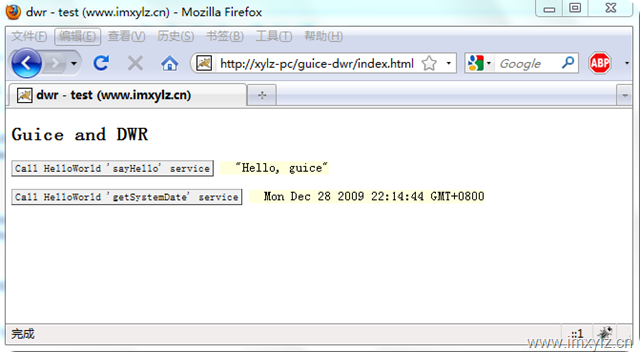4 整合第三方组件
在《Google Guice 入门教程06 – Web 和Servlet》 中我们看到了Guice 整合Struts
2的应用。本章节继续讨论Guice整合其它第三方组件的应用。
本章节重点谈Guice与DWR和Spring的整合。
4.1 整合DWR
DWR作为Ajax远程调用的服务端得到了很多程序员的追捧,在DWR的2.x版本中已经集成了Guice的插件。
老套了,我们还是定义一个HelloWorld的服务吧,哎,就喜欢HelloWorld,不怕被别人骂!
1 public interface HelloWorld {
2
3 String sayHello();
4
5 Date getSystemDate();
6 }
7
然后写一个简单的实现吧。
1 public class HelloWorldImpl implements HelloWorld {
2
3 @Override
4 public Date getSystemDate() {
5 return new Date();
6 }
7
8 @Override
9 public String sayHello() {
10 return "Hello, guice";
11 }
12 }
13
然后是与dwr有关的东西了,我们写一个dwr的listener来注入我们的模块。
1 package cn.imxylz.study.guice.web.dwr;
2
3 import org.directwebremoting.guice.DwrGuiceServletContextListener;
4
5 /**
6 * @author xylz (www.imxylz.cn)
7 * @version $Rev: 105 $
8 */
9 public class MyDwrGuiceServletContextListener extends DwrGuiceServletContextListener{
10
11 @Override
12 protected void configure() {
13 bindRemotedAs("helloworld", HelloWorld.class).to(HelloWorldImpl.class).asEagerSingleton();
14 }
15 }
16
这里使用bindRemotedAs来将我们的服务开放出来供dwr远程调用。
剩下的就是修改web.xml,需要配置一个dwr的Servlet并且将我们的listener加入其中。看看全部的内容。
1 <?xml version="1.0" encoding="UTF-8"?>
2 <web-app xmlns="http://java.sun.com/xml/ns/javaee" xmlns:xsi="http://www.w3.org/2001/XMLSchema-instance"
3 xsi:schemaLocation="http://java.sun.com/xml/ns/javaee http://java.sun.com/xml/ns/javaee/web-app_2_5.xsd"
4 version="2.5">
5
6 <display-name>guice-dwr</display-name>
7 <description>xylz study project - guice</description>
8
9 <listener>
10 <listener-class>cn.imxylz.study.guice.web.dwr.MyDwrGuiceServletContextListener
11 </listener-class>
12 </listener>
13 <servlet>
14 <servlet-name>dwr-invoker</servlet-name>
15 <servlet-class>org.directwebremoting.guice.DwrGuiceServlet</servlet-class>
16 <init-param>
17 <param-name>debug</param-name>
18 <param-value>true</param-value>
19 </init-param>
20 </servlet>
21 <servlet-mapping>
22 <servlet-name>dwr-invoker</servlet-name>
23 <url-pattern>/dwr/*</url-pattern>
24 </servlet-mapping>
25
26 </web-app>
27
非常简单,也非常简洁,其中DwrGuiceServlet的debug参数只是为了调试方便才开放的,实际中就不用写了。
好了,看看我们的效果。
1 <html>
2 <head><title>dwr - test (www.imxylz.cn) </title>
3 <script type='text/javascript' src='/guice-dwr/dwr/interface/helloworld.js'></script>
4 <script type='text/javascript' src='/guice-dwr/dwr/engine.js'></script>
5 <script type='text/javascript' src='/guice-dwr/dwr/util.js'></script>
6 <script type='text/javascript'>
7 var showHello = function(data){
8 dwr.util.setValue('result',dwr.util.toDescriptiveString(data,1));
9 }
10 var getSystemDate = function(data){
11 dwr.util.setValue('systime',dwr.util.toDescriptiveString(data,2));
12 }
13 </script>
14 <style type='text/css'>
15 input.button { border: 1px outset; margin: 0px; padding: 0px; }
16 span { background: #ffffdd; white-space: pre; padding-left:20px;}
17 </style>
18 </head>
19 <body onload='dwr.util.useLoadingMessage()'>
20 <p>
21 <h2>Guice and DWR</h2>
22 <input class='button' type='button' value="Call HelloWorld 'sayHello' service" onclick="helloworld.sayHello(showHello)" />
23 <span id='result' ></span>
24 </p>
25 <p>
26 <input class='button' type='button' value="Call HelloWorld 'getSystemDate' service" onclick="helloworld.getSystemDate(getSystemDate)" />
27 <span id='systime' ></span>
28 </P>
29 </body>
30 </html>
我们通过两个按钮来获取我们的远程调用的结果。
 我对DWR的认识也仅限于此就不献丑了。有兴趣的可以研究http://directwebremoting.org/dwr/。
我对DWR的认识也仅限于此就不献丑了。有兴趣的可以研究http://directwebremoting.org/dwr/。
4.2 整合Spring
仍然使用我们的HelloWorld服务。
1 public interface HelloWorld {
2
3 String sayHello(String user);
4 }
5
1 public class HelloWorldImpl implements HelloWorld {
2
3 @Override
4 public String sayHello(String user) {
5 return String.format("Welcome to Guice with spring, %1$s. Now is %2$tF %2$tH:%2$tM:%2$tS.", user,new Date());
6 }
7 }
8
当然了,我们定义一个简单的spring配置文件,只有一个bean。
1 <?xml version="1.0" encoding="UTF-8"?>
2 <beans xmlns="http://www.springframework.org/schema/beans"
3 xmlns:xsi="http://www.w3.org/2001/XMLSchema-instance"
4 xsi:schemaLocation="http://www.springframework.org/schema/beans
5 http://www.springframework.org/schema/beans/spring-beans-2.0.xsd">
6 <bean id="helloworld" class="cn.imxylz.study.guice.spring.HelloWorldImpl"
7 scope="singleton" />
8 </beans>
然后看我们的Demo程序。
1 public static void main(String[] args) {
2
3 final ApplicationContext context = new ClassPathXmlApplicationContext("/applicationContext.xml", GuiceSpringDemo.class);
4 Injector injector = Guice.createInjector(new AbstractModule() {
5 protected void configure() {
6 bind(BeanFactory.class).toInstance(context);
7 bind(HelloWorld.class).toProvider(SpringIntegration.fromSpring(HelloWorld.class, "helloworld"));
8 }
9 });
10 HelloWorld hw1 =injector.getInstance(HelloWorld.class);
11 String msg=hw1.sayHello("xylz");
12 System.out.println(msg);
13 HelloWorld hw2 =(HelloWorld)context.getBean("helloworld");
14 String msg2=hw2.sayHello("xylz");
15 System.out.println(msg2);
16 System.out.println(hw1==hw2);
17 }
18
最后我们通过Injector和ApplicationContext都能够得到我们的服务,并且我们的服务hw1==hw2。
如果闲一个个服务的注入麻烦,这里还有一个简便的方法,一次将spring中的所有服务都注入。
final ApplicationContext context = new ClassPathXmlApplicationContext("/applicationContext.xml", GuiceSpringDemo.class);
Injector injector = Guice.createInjector(new Module() {
@Override
public void configure(Binder binder) {
SpringIntegration.bindAll(binder, context);
}
});
但是Guice获取服务的方式就不一样了。
String msg=injector.getInstance(Key.get(HelloWorldImpl.class,
Names.named("helloworld"))).sayHello("xylz");
System.out.println(msg);
这里我们不能getInstance(HelloWorld.class)来获取一个服务了,为什么呢?因为注入所有服务的时候,Guice并不能知道我们的服务是什么类型,于是将当作实际的类型注入了,另外由于spring允许一种类型的多个服务(bean)存在,所以自动注入的时候为了区分就需要带一个命名的注解,比如我们的helloworld,这个名称就是spring中的id。在Injector中为了获取一个带注解的类型服务,我们需要com.google.inject.Key<T>对象,此对象可以讲类型和注解关联起来,这样我们就能从Guice容器中获取一个服务了。
那如果我们想屏蔽真实的服务代码,也就是我们只是想客户端拿到HelloWorld服务而不是HelloWorldImpl实现怎么做?
目前只能在spring中使用代理服务。
1 <?xml version="1.0" encoding="UTF-8"?>
2 <beans xmlns="http://www.springframework.org/schema/beans"
3 xmlns:xsi="http://www.w3.org/2001/XMLSchema-instance"
4 xsi:schemaLocation="http://www.springframework.org/schema/beans
5 http://www.springframework.org/schema/beans/spring-beans-2.0.xsd">
6 <bean id="helloworldTarget" class="cn.imxylz.study.guice.spring.HelloWorldImpl"
7 scope="singleton" />
8 <bean id="helloworld" class="org.springframework.aop.framework.ProxyFactoryBean">
9 <property name="proxyInterfaces" value="cn.imxylz.study.guice.spring.HelloWorld" />
10 <property name="target" ref="helloworldTarget" />
11 </bean>
12 </beans>
然后我们在Guice中这样获取服务:
String msg=injector.getInstance(Key.get(HelloWorld.class, Names.named("helloworld"))).sayHello("xylz");
System.out.println(msg);
显然,如果客户端知道服务的实际类型并且知道spring中的id,那么仍然可以调用我们的服务,比如下面的例子:
String msg3=injector.getInstance(Key.get(HelloWorldImpl.class, Names.named("helloworldTarget"))).sayHello("xylz");
System.out.println(msg3);
上一篇:Google Guice 入门教程06 – Web 和 Servlet
下一篇:Google Guice 入门教程08 - 整合第三方组件(2)
©2009-2014 IMXYLZ
|求贤若渴